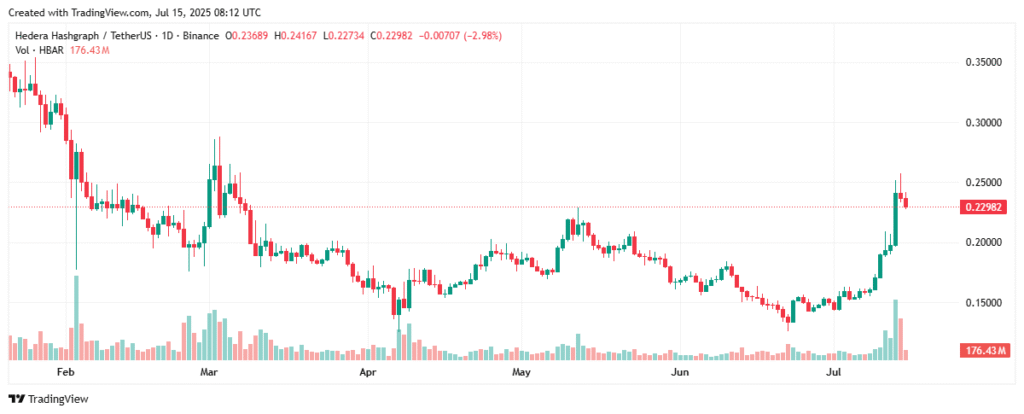HBAR is trading at $0.2313 on July 15 as its market capitalization crosses $10 billion as per TradingView the most in over four months. There is a bullish frenzy in full swing with ETF approval speculations.

The breakout of HBAR past $0.228 resistance is in agreement with a bullish breakout. A daily close past this barrier would confirm market direction reversal, likely igniting a 71% move towards the $0.392–$0.40 range as long as momentum is sustained.
Awesome Oscillator bars are accumulating in the positive domain, a sign of rising buyer interest. The 20-day EMA is coming in for a crossover above the 200-day EMA as well, another sign of mounting intra-day bullish pressure.
Considering 2025 forecasts, HBAR can range around $0.2408 until July and August. Predictions vary between $0.1942 and $0.2408 in the short term, as most analysts comment on $0.40 in August as being ambitious.
HBAR Forecast: Can It Reach $0.40 or Fail?
If HBAR manages to finish above $0.27 in Q3 or Q4, it may reach $0.40, Crypto analysts remain cautious. Predictions primarily suggest HBAR will trade between $0.2408 this month, with possible lows at $0.1942.
Some predictions have HBAR trading between $0.2239 and $0.2351 in July. There are some analysts predicting a spectacular breakout in October towards $0.5458, but this is speculation only and far from consensus levels.
Wider expectations show HBAR trading between $0.15 and $0.30 in July. That would make $0.40 in August too bullish unless there is some kind of breakout in the near term. Current data simply can’t support that target at this point.
HBAR Breaks Bullish Chart Pattern
Other end-of-the-year forecasts extend as far as $1.28 for HBAR. That is a long-term forecast, however, not a near-term target. Nonetheless, it implies there is significant potential for gains if sentiment stays bullish.
Technically, HBAR is bullish. It’s broken out of a rounded bottom structure, a classic bullish reversal structure. There is immense buying interest with an RSI of 85.23, but there is a potential near-term correction risk.







